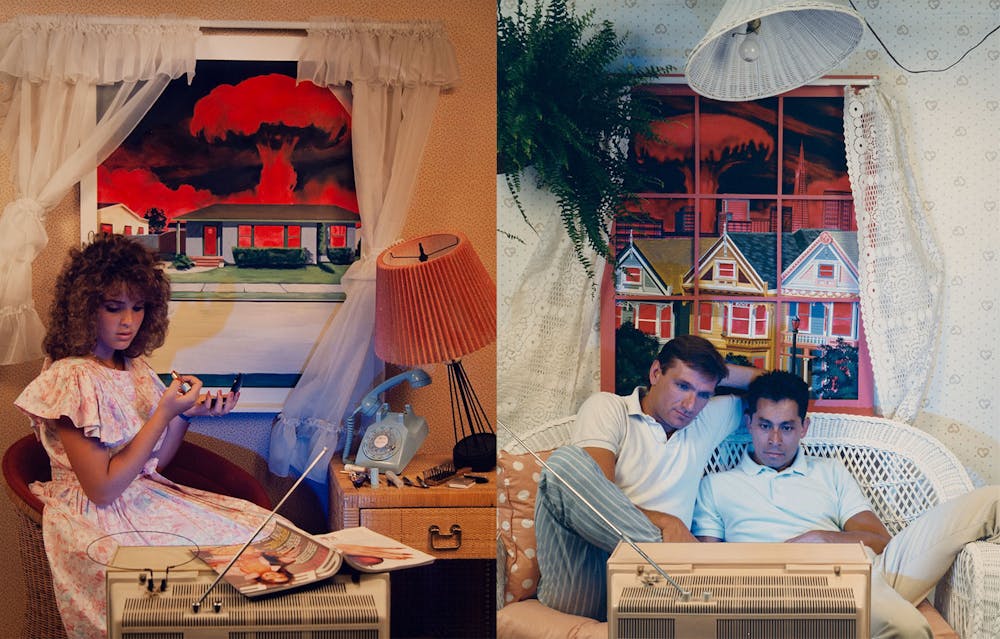Dimly lit gray walls enclose “Radioactive Inactives,” a striking photography exhibit currently displayed at The Fralin Museum of Art. The series of photos was originally created by artists Patrick Nagatani and Andrée Tracey from 1987 to 1988, as they meshed their artistic talent to reveal poignant messages about the darker realities of the modern world.
Against the muted exhibition setting, the eleven fictional portraits are all spotlit, each notably taking place somewhere in the United States. Each photo depicts a person or persons dressed in vintage attire, watching TV as red mushroom clouds explode from out the window behind them.
A continuity between portraits exists in the contrasting of domestic motifs with fiery red billows of atomic smoke — painted backdrops representing windows created by painter, illustrator and collage artist Tracey.
Tracey’s prolific art has been shown all over the country and the world, in institutions such as the Bibliothèque Nationale in Paris and the Tokyo Museum in Japan. Tracey worked with Nagatani for six years, and on her own has created dynamic paintings filled with action and bright, eye-catching colors.
When it comes to the origins of “Radioactive Inactives,” Tracey and Nagatani’s collaboration stemmed from the fact that her and Nagatani’s studios were close. Additionally, Nagatani and Tracey both had experience in the film industry, as Nagatani built sets while Tracey created storyboards.
Their initial collaboration began with a photographic presentation at the Museum of Photographic Arts in San Diego, but it did not end there.
“They were so pleased with the results, [the] Polaroid company was, that they invited us to come back to New York the following year to work with the cameraman there and present new installations and new photography,” Tracey said.
The success of Tracey and Nagatani’s collaboration — and a reason their art worked so well together — can also be accredited to a shared fondness for darker humor coupled with social commentary, This humor and commentary are especially illustrated in the short narratives Nagatani and Tracey wrote to accompany each photo, giving context to each person’s fictionalized life.
These geographically and socially diverse Americans sit engrossed in their separate realities, connected to their own space and to televised media. Their physical worlds have been altered, and they are painfully unaware of that fact, a scene that spreads a message of detachment Tracey says is still relevant 30 years after the creation of these photos.
“We get our news from social media, from Instagram, from Facebook, from TikTok…and we're just bombarded with various sources of information,” Tracey said. “We are sort of detached from reality in a way just because of that.”
Tracey clearly empathized with these fictional identities instead of blaming them individually for their faults, hinting at the idea of greater societal issues being the core problem.
“Everybody in these portraits is just trying to make the best of the hand they were dealt,” Tracey said. “So they all have these stories, and they're all just…trying to get through the next 24 hours, which kind of puts the major events that are happening outside on the back burner.”
Tracey also reiterated how the nature of this exhibit is truly up for interpretation. Upon one of the wall labels within the exhibit, curated by Hannah Cattarin, assistant curator at the Fralin, a lens critiquing capitalism is taken.
“The system, by design, reinforces inequitable hierarchies that prompt us to focus on the self over the collective as we aspire to ‘climb the ladder,’” the wall reads. “This results in the individualization of problems stemming from structural oppression and shifts criticism away from systems of power, like capitalism.”
The core idea of individualization of problems is exactly what “Radioactive Inactives” illustrates as a jarring issue. Tracey said she found that her photos could help serve to be a wake-up call of sorts for the various problems that result from the way our society is changing in this manner.
“We just have to face the fact that our environment is changing, our lifestyles are being compromised, and our future is compromised, our children are compromised,” Tracey said. “We need to wake up and work together.”
Take some time to holistically explore Tracey and Nagatani’s photography and respective narratives — and allow their messages to inspire a new, far more interconnected future — at “Radioactive Inactives,” open at The Fralin through Nov. 26.







